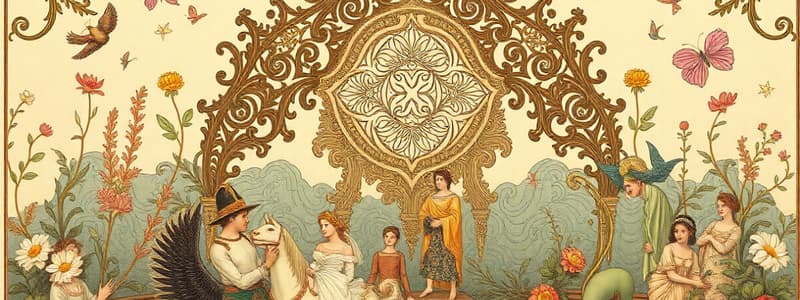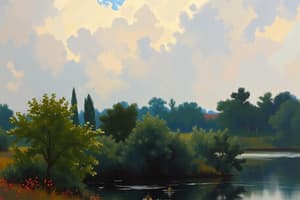Podcast
Questions and Answers
What are fine motor skills primarily associated with?
What are fine motor skills primarily associated with?
- Movements made by smaller muscles, mainly in the hands and wrists (correct)
- Non-verbal arts that require full body movement
- Movements made by larger muscle groups
- Art forms that utilize both verbal and non-verbal elements
Which characteristic is associated with the period of art history labeled as 'Pre-historic'?
Which characteristic is associated with the period of art history labeled as 'Pre-historic'?
- Utilization of advanced materials and techniques
- Construction of elaborate architectural structures
- Engagement in complex artistic expression and settled life
- Nomadic lifestyle and creation of primitive art (correct)
What is meant by mixed art?
What is meant by mixed art?
- Art that is created using only physical materials
- An integration of both verbal and non-verbal artistic expressions (correct)
- Art that relies solely on verbal expression
- Art forms that do not require any language
Which of the following is considered a gross motor skill activity?
Which of the following is considered a gross motor skill activity?
During which age did the art of pottery-making for food and water containers develop?
During which age did the art of pottery-making for food and water containers develop?
How has art history been characterized regarding its cultural perspective?
How has art history been characterized regarding its cultural perspective?
What type of art involves literary forms such as poetry, fiction, and essays?
What type of art involves literary forms such as poetry, fiction, and essays?
Which of the following is an example of a gross motor art activity?
Which of the following is an example of a gross motor art activity?
Which of the following best describes the distinction between art and craft?
Which of the following best describes the distinction between art and craft?
Which element of art is primarily concerned with the lightness or darkness of a color?
Which element of art is primarily concerned with the lightness or darkness of a color?
In the context of creativity, which of the following is considered a metacognitive skill?
In the context of creativity, which of the following is considered a metacognitive skill?
What term is used to describe the study of chronological records of events?
What term is used to describe the study of chronological records of events?
Which of the following definitions aligns with the concept of Humanities?
Which of the following definitions aligns with the concept of Humanities?
What characteristic distinguishes a three-dimensional form in art?
What characteristic distinguishes a three-dimensional form in art?
What does the term 'Texture' refer to in the context of art elements?
What does the term 'Texture' refer to in the context of art elements?
Which of the following statements best describes the relationship between art and beauty?
Which of the following statements best describes the relationship between art and beauty?
Flashcards are hidden until you start studying
Study Notes
Creativity
- A skill that involves thinking outside the box and engaging in an unstructured, free-flowing process.
- Two forms: Art and Craft.
- Art is emotional, beautiful, and imaginative, while craft is useful, practical, and systematic.
Humanities
- Focus on human beings and their knowledge.
- Include philosophy, literature, art, history, and language.
Literature
- A collection of written works, including novels, plays, and poems.
- Used for recording, preserving, and transmitting knowledge and entertainment.
Philosophy
- Means "love of wisdom."
- Aims to understand fundamental truths about human beings.
History
- Studies the chronological record of events.
Language
- Complex systems of communication.
Nature
- Considered the art of God.
Elements of Art
- Line: Foundation of drawing, suggesting shape, pattern, form, structure, growth, depth, distance, etc.
- Shape: Two-dimensional (flat) or three-dimensional (cube, sphere, pyramid, cylinder).
- Space: Feeling of depth, artists utilize positive or negative space within a picture.
- Value: Lightness or darkness of a color.
- Form: Connotes something three-dimensional.
- Texture: Perceived surface quality, tactile or visual.
- Color: Created by reflected light, consisting of hue, chroma (intensity), and value.
Classifications of Art
- Verbal: Uses words and language, like poetry, fiction, and essays.
- Non-Verbal: Uses motor skills, categorized into fine motor and gross motor:
- Fine Motor: Uses smaller muscles, precise movements (e.g., musical compositions, drawing, architecture, graphic arts).
- Gross Motor: Uses large muscles for movement (e.g., interior design, ceramics, film-making, photography).
- Mixed: Combines verbal and non-verbal elements (e.g., advertisements, theater, opera, dance, cinema).
Art History
- Begun with the emergence of humans, expressing their imagination through great legacies.
- As old as history itself.
- Early art reflects the struggle for power, security, and survival.
- Marked by a Eurocentric bias due to Western influence and historical control.
Periods of Art History
- Pre-Historic Period: Nomadic life, primitive art using stone tools, hunting, animal skins for clothing.
- Mesolithic Age: Tool-making improved, using nets and hooks for fishing, domestication of animals.
- Neolithic Age: Settled life, farming, animal domestication, pottery-making.
- Ancient Period: Architectural construction using stones and bricks.
Studying That Suits You
Use AI to generate personalized quizzes and flashcards to suit your learning preferences.




